初心者向けのAZ-104試験 [2023] 問題集でMicrosoftのPDF問題
AZ-104プレミアム試験エンジンPDFをダウンロード
Microsoft AZ-104試験は、Azure管理のスキルと知識を検証する優れた機会です。クラウドコンピューティングのキャリアを進めたいITプロフェッショナルにとって貴重な認定資格です。
Microsoft AZ-104認定試験に合格した候補者は、Microsoft認定Azure管理者として認識されています。この認定は、Azureリソースの管理、ストレージソリューションの実装と管理、仮想ネットワークの構成と管理、Azure Resourcesの監視とバックアップに関する専門知識を検証します。この認定は、Azureのアイデンティティとガバナンスの管理、Azure計算リソースの実装と管理の習熟度も実証しています。 Microsoft Azure Administrator認定は、クラウドコンピューティング業界でキャリアを進め、Microsoft Azureの管理に関する専門知識を実証したい個人にとって不可欠な認定です。
質問 # 39
You have an Azure subscription that contains the virtual machines shown in the following table.
VM1 and VM2 use public IP addresses. From Windows Server 2019 on VM1 and VM2, you allow inbound Remote Desktop connections.
Subnet1 and Subnet2 are in a virtual network named VNET1.
The subscription contains two network security groups (NSGs) named NSG1 and NSG2. NSG1 uses only the default rules.
NSG2 uses the default and the following custom incoming rule:
Priority: 100
Name: Rule1
Port: 3389
Protocol: TCP
Source: Any
Destination: Any
Action: Allow
NSG1 connects to Subnet1. NSG2 connects to the network interface of VM2.
For each of the following statements, select Yes if the statement is true. Otherwise, select No.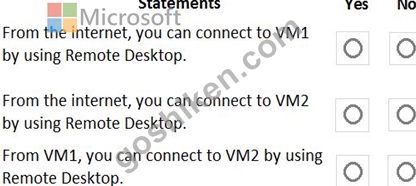
正解:
解説: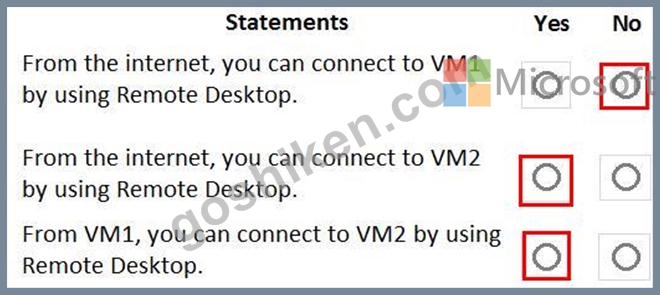
Reference:
https://docs.microsoft.com/en-us/azure/virtual-machines/troubleshooting/troubleshoot-rdp-connection
質問 # 40
Note: This question is part of a series of questions that present the same scenario. Each question in the series contains a unique solution that might meet the stated goals. Some question sets might have more than one correct solution, while others might not have a correct solution.
After you answer a question in this section, you will NOT be able to return to it. As a result, these questions will not appear in the review screen.
You have an app named App1 that is installed on two Azure virtual machines named VM1 and VM2.
Connections to App1 are managed by using an Azure Load Balancer.
The effective network security configurations for VM2 are shown in the following exhibit.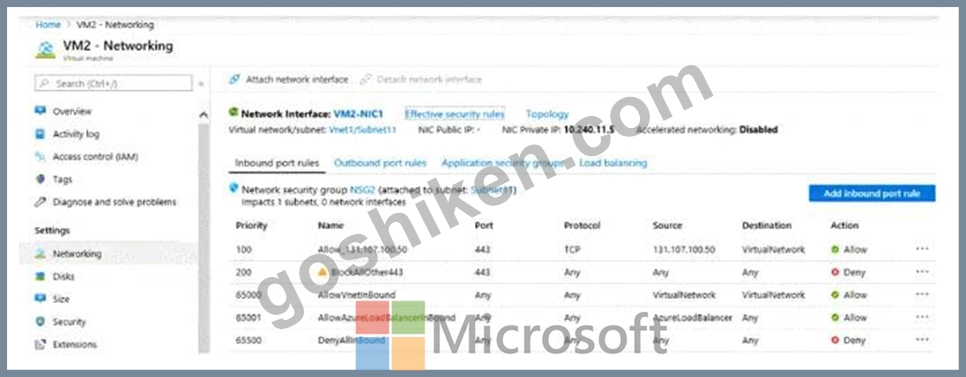
You discover that connections to App1 from 131.107.100.50 over TCP port 443 fail. You verify that the Load Balancer rules are configured correctly.
You need to ensure that connections to App1 can be established successfully from 131.107.100.50 over TCP port 443.
Solution: You modify the priority of the Allow_131.107.100.50 inbound security rule.
Does this meet the goal?
- A. Yes
- B. No
正解:A
質問 # 41
You need to recommend a solution for App1. The solution must meet the technical requirements. What should you include in the recommendation? To answer, select the appropriate options in the answer area.
NOTE: Each correct selection is worth one point.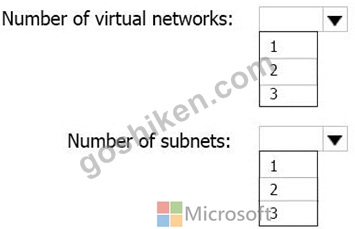
正解:
解説: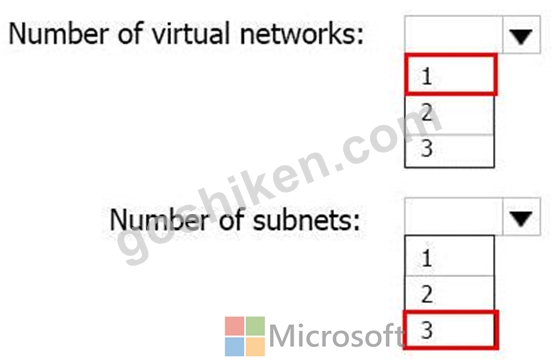
質問 # 42
You have an Azure subscription that contains an Azure virtual machine named VM1. VM1 runs Windows Server 2016 and is part of an availability set.
VM1 has virtual machine-level backup enabled.
VM1 is deleted.
You need to restore VM1 from the backup. VM1 must be part of the availability set.
Which three actions should you perform in sequence? To answer, move the appropriate actions from the list of actions to the answer area and arrange them in the correct order.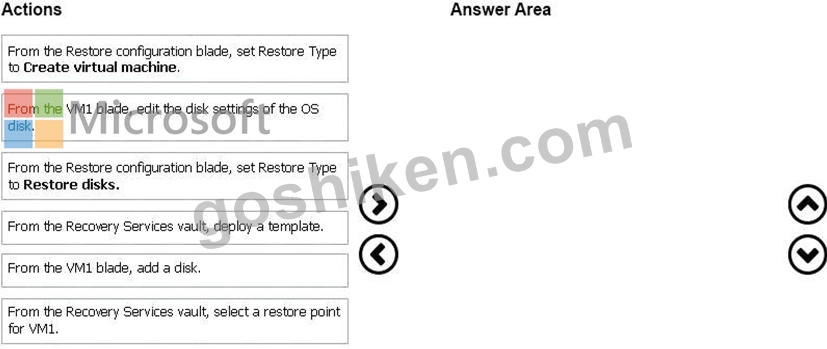
正解:
解説: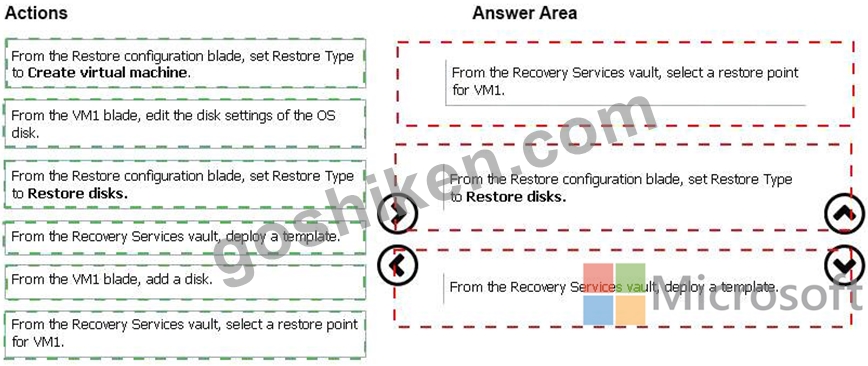
Explanation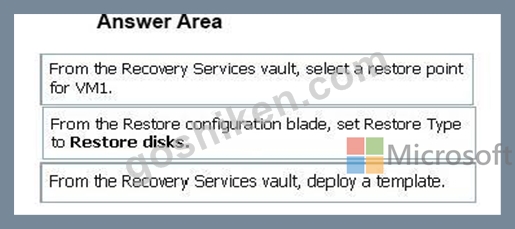
質問 # 43
You have an Azure subscription that contains an Azure Service Bus named Bus1.
Your company plans to deploy two Azure web apps named App1 and App2. The web apps will create messages that have the following requirements:
Each message created by App1 must be consumed by only a single consumer Each message created by App2 will be consumed by multiple consumers.
Which resource should you create for each web app? To answer, drag the appropriate resources to the correct web apps. Each resource may be used once, more than once, or not at all. You may need to drag the split bar between panes or scroll to view content.
NOTE: Each correct selection is worth one point.
正解:
解説:
Reference:
https://docs.microsoft.com/en-us/azure/service-bus-messaging/service-bus-queues-topics-subscriptions
質問 # 44
You need to create storage5. The solution must support the planned changes.
Which type of storage account should you use, and which account should you configure as the destination storage account? To answer, select the appropriate options in the answer area.
NOTE: Each correct selection is worth one point.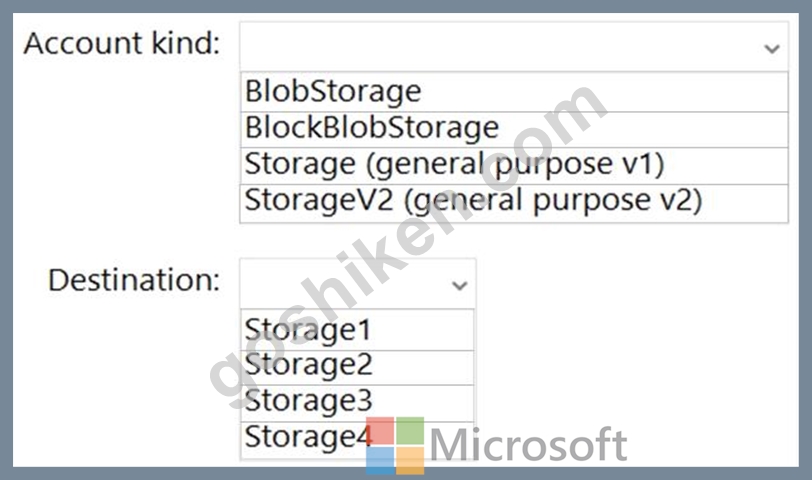
正解:
解説: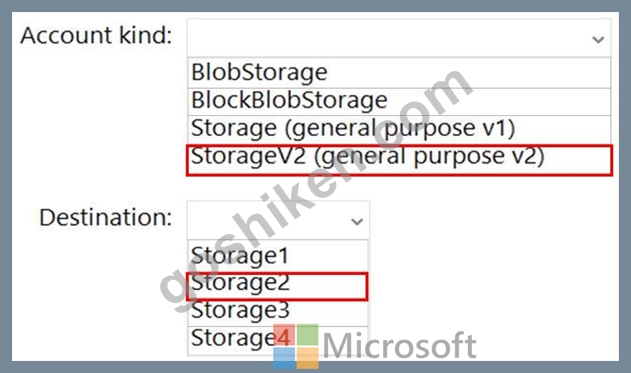
Reference:
https://docs.microsoft.com/en-us/azure/storage/blobs/object-replication-configure?tabs=portal
質問 # 45
You have an Azure subscription that contains an Azure virtual machine named VM1. VM1 runs Windows Server 2016 and is part of an availability set.
VM1 has virtual machine-level backup enabled.
VM1 is deleted.
You need to restore VM1 from the backup. VM1 must be part of the availability set.
Which three actions should you perform in sequence? To answer, move the appropriate actions from the list of actions to the answer area and arrange them in the correct order.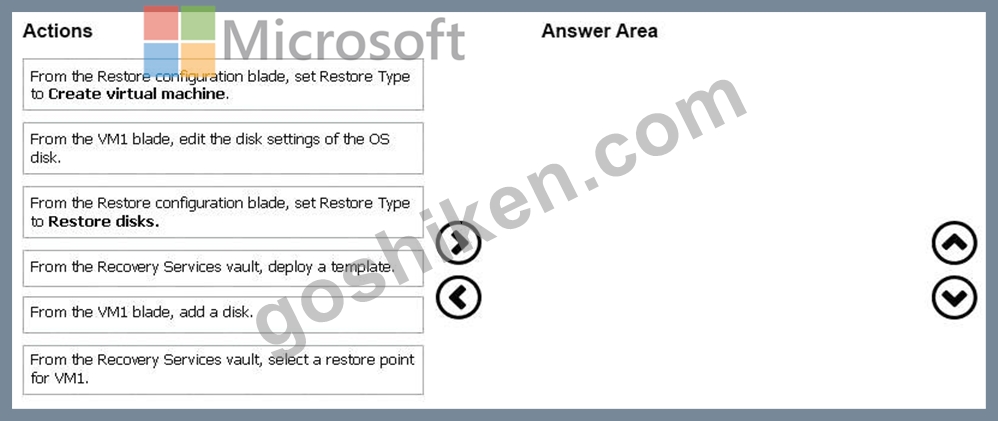
正解:
解説: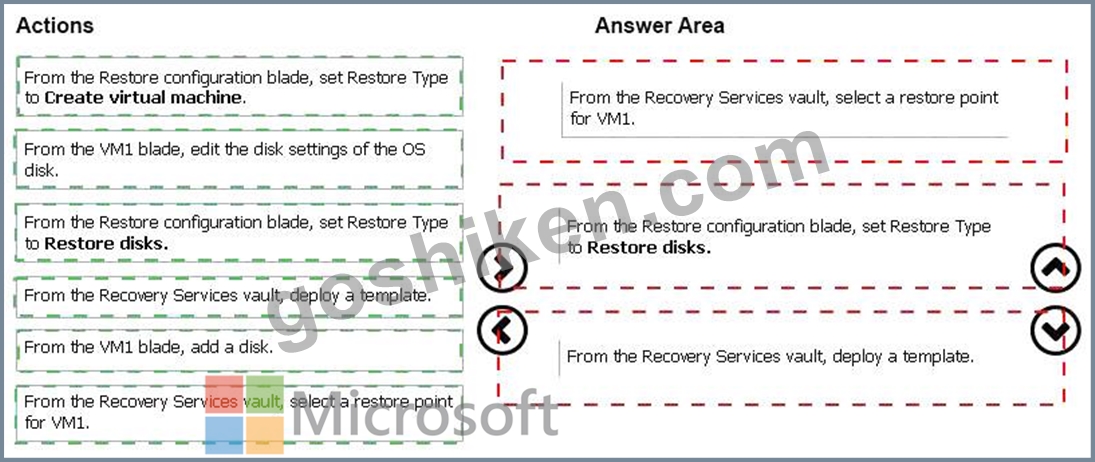
Explanation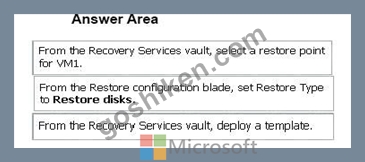
質問 # 46
You need to create an Azure Storage account that meets the following requirements:
* Minimizes costs
* Supports hot, cool, and archive blob tiers
* Provides fault tolerance if a disaster affects the Azure region where the account resides How should you complete the command? To answer, select the appropriate options in the answer area. NOTE:
Each correct selection is worth one point
正解:
解説:
Box 1: StorageV2
You may only tier your object storage data to hot, cool, or archive in Blob storage and General Purpose v2 (GPv2) accounts. General Purpose v1 (GPv1) accounts do not support tiering.
General-purpose v2 accounts deliver the lowest per-gigabyte capacity prices for Azure Storage, as well as industry-competitive transaction prices.
Box 2: Standard_GRS
Geo-redundant storage (GRS): Cross-regional replication to protect against region-wide unavailability.
質問 # 47
HOTSPOT
You have a pay-as-you-go Azure subscription that contains the virtual machines shown in the following table.
You create the budget shown in the following exhibit.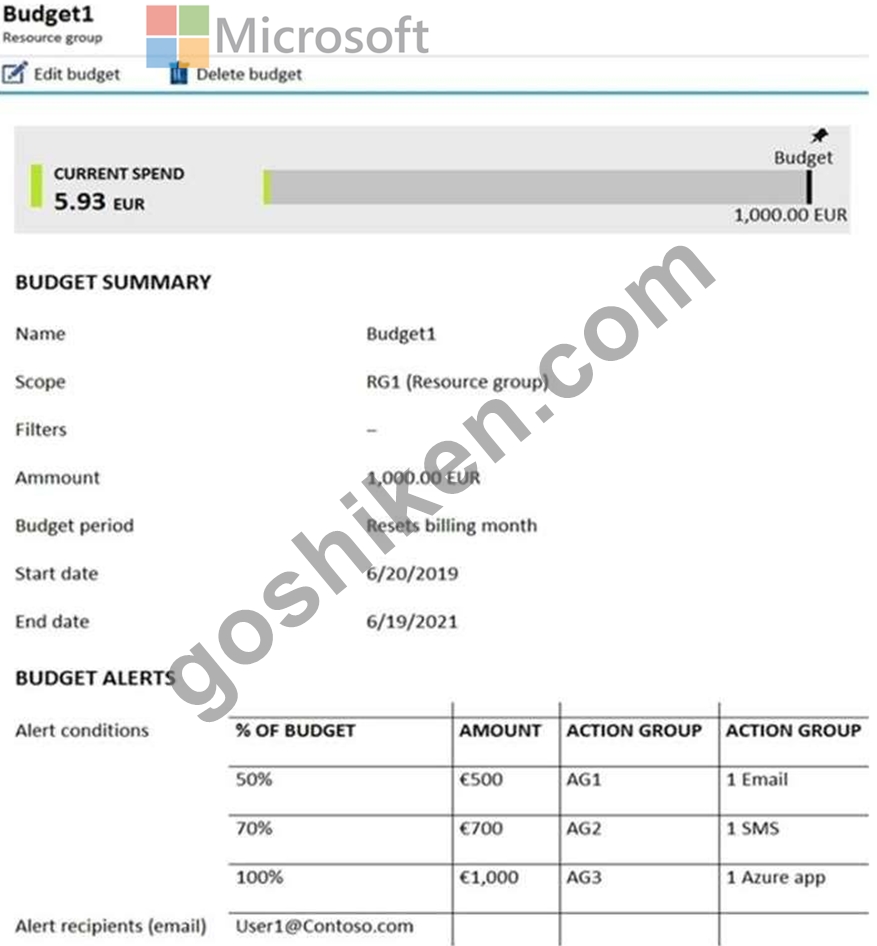
The AG1 action group contains a user named [email protected] only.
Use the drop-down menus to select the answer choice that completes each statement based on the information presented in the graphic.
Hot Area: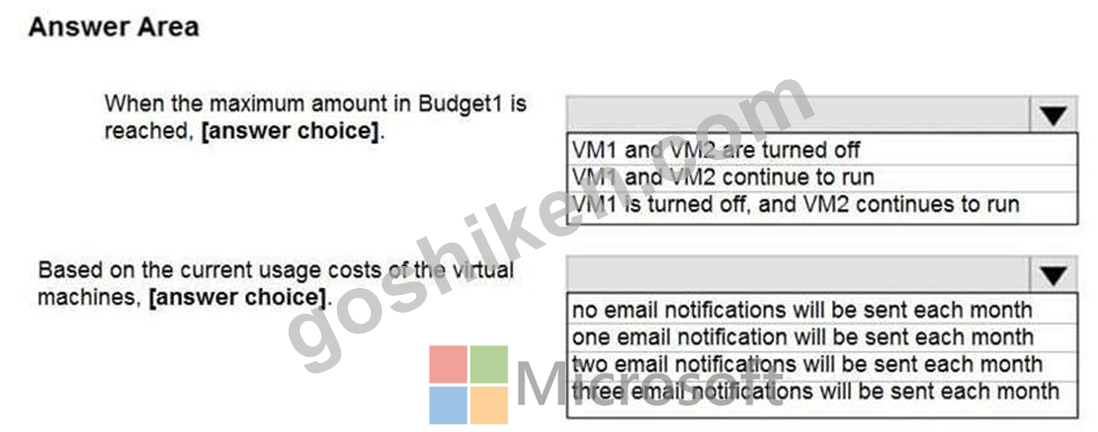
正解:
解説: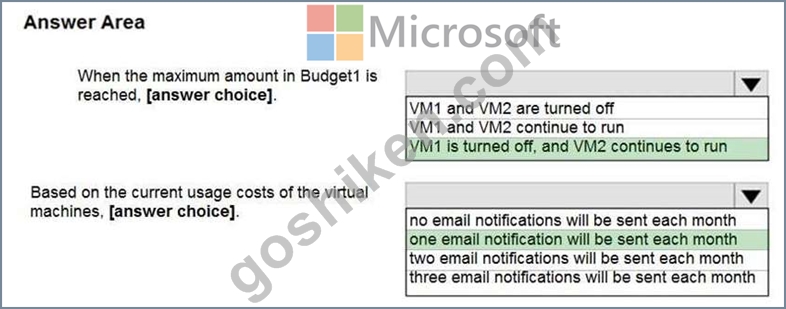
Section: [none]
Explanation:
Box 1: VM1 is turned off, and VM2 continues to run
The budget alerts are for Resource Group RG1, which include VM1, but not VM2.
Box 2: one email notification will be sent each month.
Budget alerts for Resource Group RG1, which include VM1, but not VM2.VM1 consumes 20 Euro/day. The
50%, 500 Euro limit, will be reached in 25 days, and an email will be sent.
The 70% and 100% alert conditions will not be reached within a month, and they don't trigger email actions anyway.
Credit alerts: Credit alerts are generated automatically at 90% and at 100% of your Azure credit balance.
Whenever an alert is generated, it's reflected in cost alerts and in the email sent to the account owners. 90% and 100% will not be reached though.
Reference:
https://docs.microsoft.com/en-us/azure/cost-management-billing/costs/cost-mgt-alerts-monitor-usage-spending
質問 # 48
You have an Azure subscription that contains 10 virtual machines.
You need to ensure that you receive an email message when any virtual machines are powered off, restarted, or deallocated.
What is the minimum number of rules and action groups that you require?
- A. three rules and one action group
- B. three rules and three action groups
- C. one rule and one action group
- D. one rule and three action groups
正解:A
解説:
An action group is a collection of notification preferences defined by the user. Azure Monitor and Service
Health alerts are configured to use a specific action group when the alert is triggered. Various alerts may use the same action group or different action groups depending on the user's requirements.
質問 # 49
You are troubleshooting a performance issue for an Azure Application Gateway.
You need to compare the total requests to the failed requests during the past six hours.
What should you use?
- A. Diagnostics logs in Application Gateway
- B. Connection monitor in Azure Network Watcher
- C. Metrics in Application Gateway
- D. NSG flow logs in Azure Network Watcher
正解:C
解説:
Explanation
Application Gateway currently has seven metrics to view performance counters.
Metrics are a feature for certain Azure resources where you can view performance counters in the portal. For Application Gateway, the following metrics are available:
* Total Requests
* Failed Requests
* Current Connections
* Healthy Host Count
* Response Status
* Throughput
* Unhealthy Host count
You can filter on a per backend pool basis to show healthy/unhealthy hosts in a specific backend pool References: https://docs.microsoft.com/en-us/azure/application-gateway/application-gatewaydiagnostics# Metrics
質問 # 50
You have peering configured as shown in the following exhibit.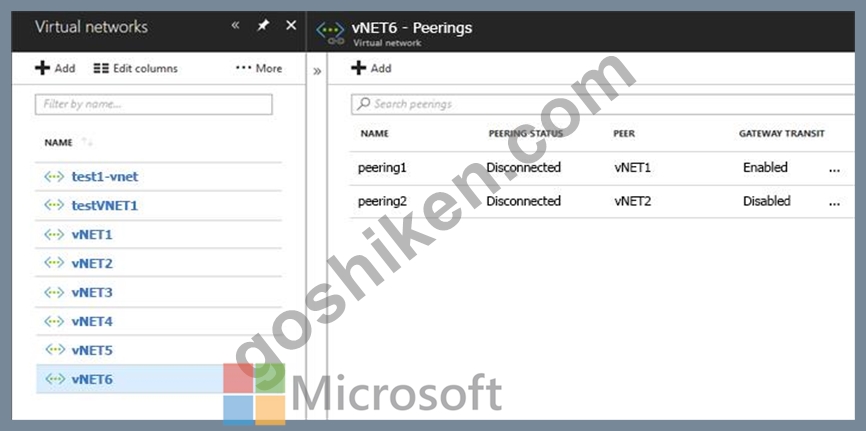
Use the drop-down menus to select the answer choice that completes each statement based on the information presented in the graphic.
NOTE: Each correct selection is worth one point.
正解:
解説: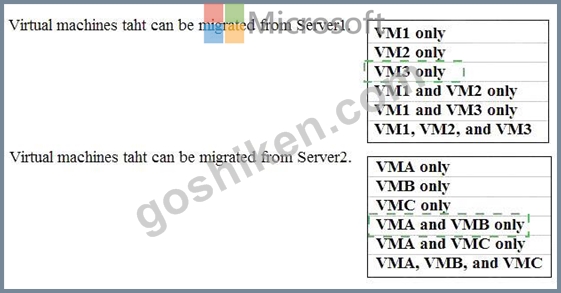
Explanation
Box 1: vNET6 only
Peering status to both VNet1 and Vnet2 are disconnected.
Box 2: delete peering1
Peering to Vnet1 is Enabled but disconnected. We need to update or re-create the remote peering to get it back to Initiated state.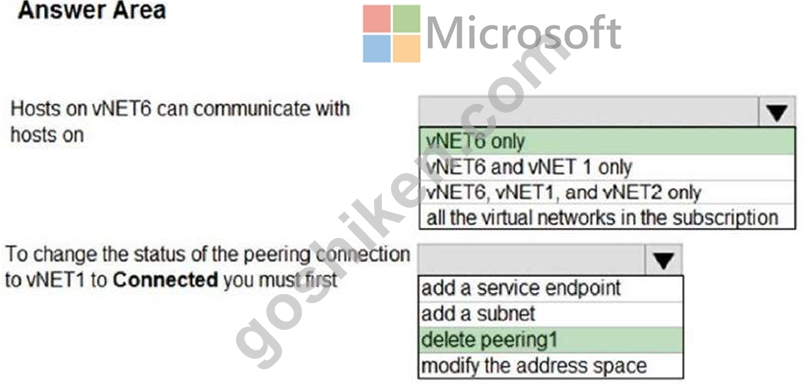
Reference:
https://blog.kloud.com.au/2018/10/19/address-space-maintenance-with-vnet-peering/
https://docs.microsoft.com/en-us/azure/virtual-network/virtual-network-manage-peering#requirements-andconstr
質問 # 51
You have an Azure subscription that contains a virtual network named VNet1. VNet1 uses an IP address space of 10.0.0.0/16 and contains the subnets in the following table.
Subnet1 contains a virtual appliance named VM1 that operates as a router.
You create a routing table named RT1.
You need to route all inbound traffic to VNet1 through VM1.
How should you configure RT1? To answer, select the appropriate options in the answer area.
NOTE: Each correct selection is worth one point.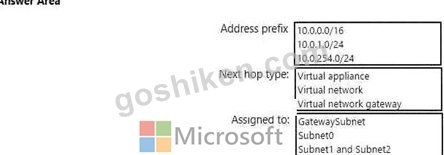
正解:
解説: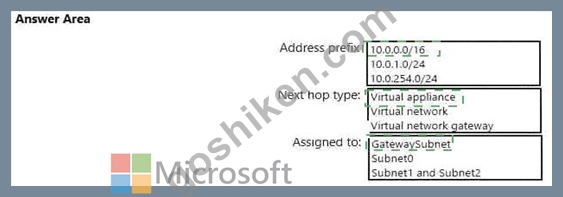
Explanation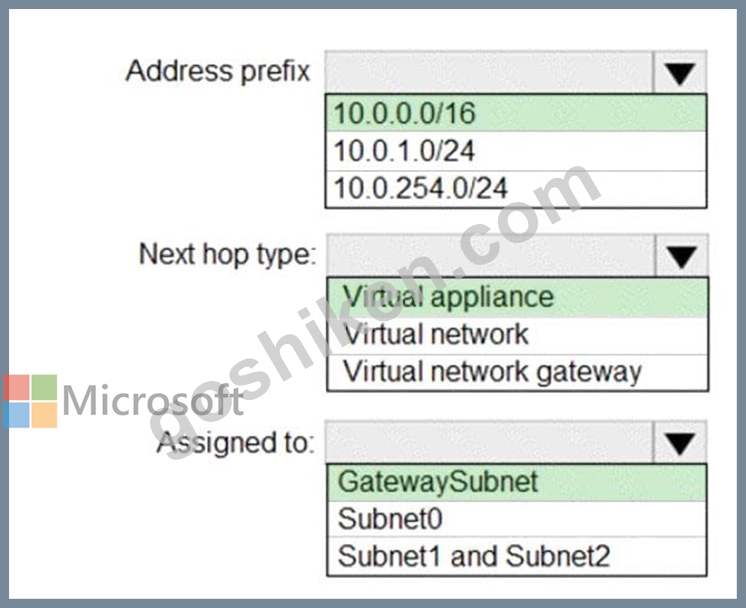
質問 # 52
You plan to use the Azure Import/Export service to copy files to a storage account.
Which two files should you create before you prepare the drives for the import job? Each correct answer presents part of the solution.
NOTE: Each correct selection is worth one point.
- A. a PowerShell PS1 file
- B. a JSON configuration file
- C. a dataset CSV file
- D. a driveset CSV file
- E. an XML manifest file
正解:C、D
解説:
B: Modify the driveset.csv file in the root folder where the tool resides.
C: Modify the dataset.csv file in the root folder where the tool resides. Depending on whether you want to import a file or folder or both, add entries in the dataset.csv file
References:
https://docs.microsoft.com/en-us/azure/storage/common/storage-import-export-data-to-files
質問 # 53
You have a virtual network named VNET1 that contains the subnets shown in the following table:
You have two Azure virtual machines that have the network configurations shown in the following table:
For NSG1, you create the inbound security rule shown in the following table:
For NSG2, you create the inbound security rule shown in the following table:
For each of the following statements, select Yes if the statement is true. Otherwise, select No.
NOTE: Each correct selection is worth one point.
正解:
解説: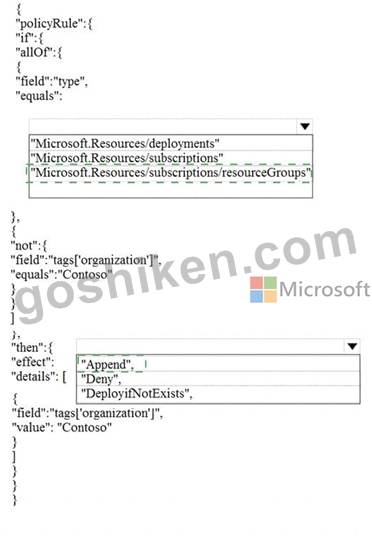
Explanation
Box 1: Yes
The inbound security rule for NSG1 allows TCP port 1433 from 10.10.2.0/24 (or Subnet2 where VM2 and VM3 are located) to 10.10.1.0/24 (or Subnet1 where VM1 is located) while the inbound security rule for NSG2 blocks TCP port 1433 from 10.10.2.5 (or VM2) to 10.10.1.5 (or VM1). However, the NSG1 rule has a higher priority (or lower value) than the NSG2 rule.
Box 2: Yes
No rule explicitly blocks communication from VM1. The default rules, which allow communication, are thus applied.
Box 3: Yes
No rule explicitly blocks communication between VM2 and VM3 which are both on Subnet2. The default rules, which allow communication, are thus applied.
Reference:
https://docs.microsoft.com/en-us/azure/virtual-network/security-overview
質問 # 54
You have an Azure subscription that contains an Azure Storage account.
You plan to copy an on-premises virtual machine image to a container named vmimages.
You need to create the container for the planned image.
Which command should you run? To answer, select the appropriate options in the answer area.
NOTE: Each correct selection is worth one point.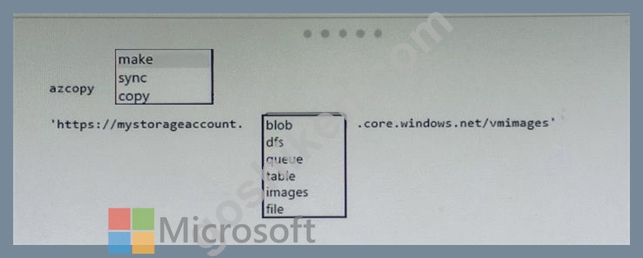
正解:
解説: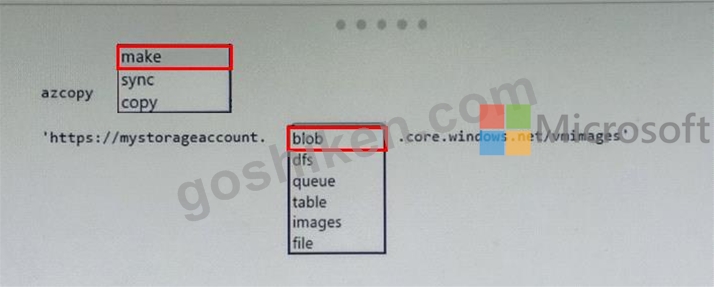
Explanation:
Box 1: make
Here the purpose is to 'create a container". So the correct command would be azcopy make.
Box 2: blob
The requirement is for storing that image, it's not used to build AKS. So blob is correct option.
Reference:
https://adamtheautomator.com/azcopy-copy-files/
質問 # 55
......
この試験は、Azureと協力し、さまざまなAzureサービスの管理と監視に関する専門知識を実証したい管理者を対象としています。認定試験では、Azureのアイデンティティとガバナンス、Azure Compute、Azure Storage、Azure Networking、Azureの監視とバックアップなど、幅広いトピックをカバーしています。これらのトピックは、Azureの管理者になりたいと考えている専門家にとって非常に重要です。
あなたを合格させるMicrosoft試験にはAZ-104試験問題集:https://www.goshiken.com/Microsoft/AZ-104-mondaishu.html
